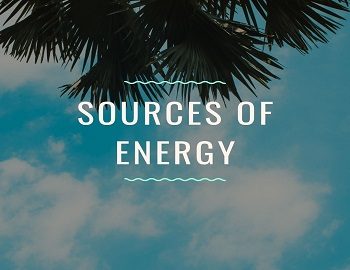Sources of Energy:
Energy is the capacity of doing work. Work is always done at the expense of energy in a body. When a body does some work, there is a change in the energy of the body. The food we take gives us energy to do work. When we do work, this energy is changed into some other form of energy like mechanical energy. The non-living things like a motor cycle also do work. The engine converts the chemical energy stored in the fuel into heat and then into mechanical energy of motion. When the petrol in a motor cycle is consumed, it stops working.
We shall now discuss some important sources of energy.
- Fossil Fuels- This is an important source of energy. A large amount of energy is obtained by burning of coal and oil. Millions of years ago, the plants and animals got buried under the earth and decayed resulting in the formation of vast under-ground beds of coal and petroleum oil.
- Winds- Wind (air in motion) possesses kinetic energy. This kinetic energy of the wind is primarily used for running a windmill in order to grind wheat into flour and to do some other useful work for a long time.
- Water Energy (Rivers)- Like the wind, water also possesses a vast amount of energy. The dams have been constructed over the rivers. The water stored at a great height is allowed to fall over generators which convert the mechanical (potential as well as kinetic) energy into the electrical energy. Waterfall also possesses both potential as well as kinetic energy. A device called watermill has been constructed to utilize the mechanical energy of waterfall for grinding of wheat into flour.
- Energy from sea waves- Recently, attempts have been made to harness the energy of the sea waves. During the high tides in the sea, the water of tides is used to generate power. India has great potential to build tidal power stations particularly in the Gulf of Cambay in Gujarat and Sunderbans in West Bengal.
- Solar Energy- Sun provides a large amount of energy to the earth every day. This energy is referred to as Solar energy. Sun is a big source of energy available on earth. Nearly 1-kilowatt energy is available from the sun at mid-day over 1 square metre of the surface of the earth. Solar energy is used for cooking food, keeping houses hot and solar batteries of artificial satellites. For this purpose, the devices such as solar cookers, solar pumps, solar batteries and solar radiators have been constructed to make use of available solar energy. The efforts are on the way to use solar energy for the commercial generation of electricity in the near future.
- Energy from Waste Products of Animals- Cattle dung is an indigenous fuel commonly referred to as Gobar gas or biogas. Gobar gas essentially contains methane gas and is obtained from waste products of animals. The cattle dung on fermentation yields a combustible gas known as methane which burns with a blue and smokeless flame. This is primarily used for cooking and lighting purposes.
- Chemical Energy- The chemical reactions taking place in cells and batteries also provide a large amount of energy. The chemical energy produced in cells and batteries is converted into the mechanical energy of motion. This energy is used for doing some useful work, particularly in automobile works.
- Electrical Energy- Electricity is an important source of energy. Electrical energy is generated either from water or coal. In India, a large quantity of electricity is obtained from water. This energy is made to do a number of jobs. In addition to this, electrical energy can also be obtained from nuclear reactors.
- Nuclear Energy- This is another promising source of energy. When nuclear reactions are brought about by the process of fission or fusion, a tremendous amount of energy is released. This is referred to as nuclear energy. The fisssionable materials like uranium, plutonium etc. undergo the process of fission and thus, release energy which can be made to do a variety of jobs like a generation of electrical energy.
- Biomass Energy- Biomass is an alternate source of energy. The process of photosynthesis by which the plants convert solar energy into biomass uses only a small amount of solar energy. Biomass, thus, includes both terrestrial as well as the aquatic matter that may be burnt or converted into fuels.
In contrast to fossil source, biomass gives clean energy. Its wider use will result in a cleaner environment and, thus, prevent the ecological imbalance.









Comments (No)